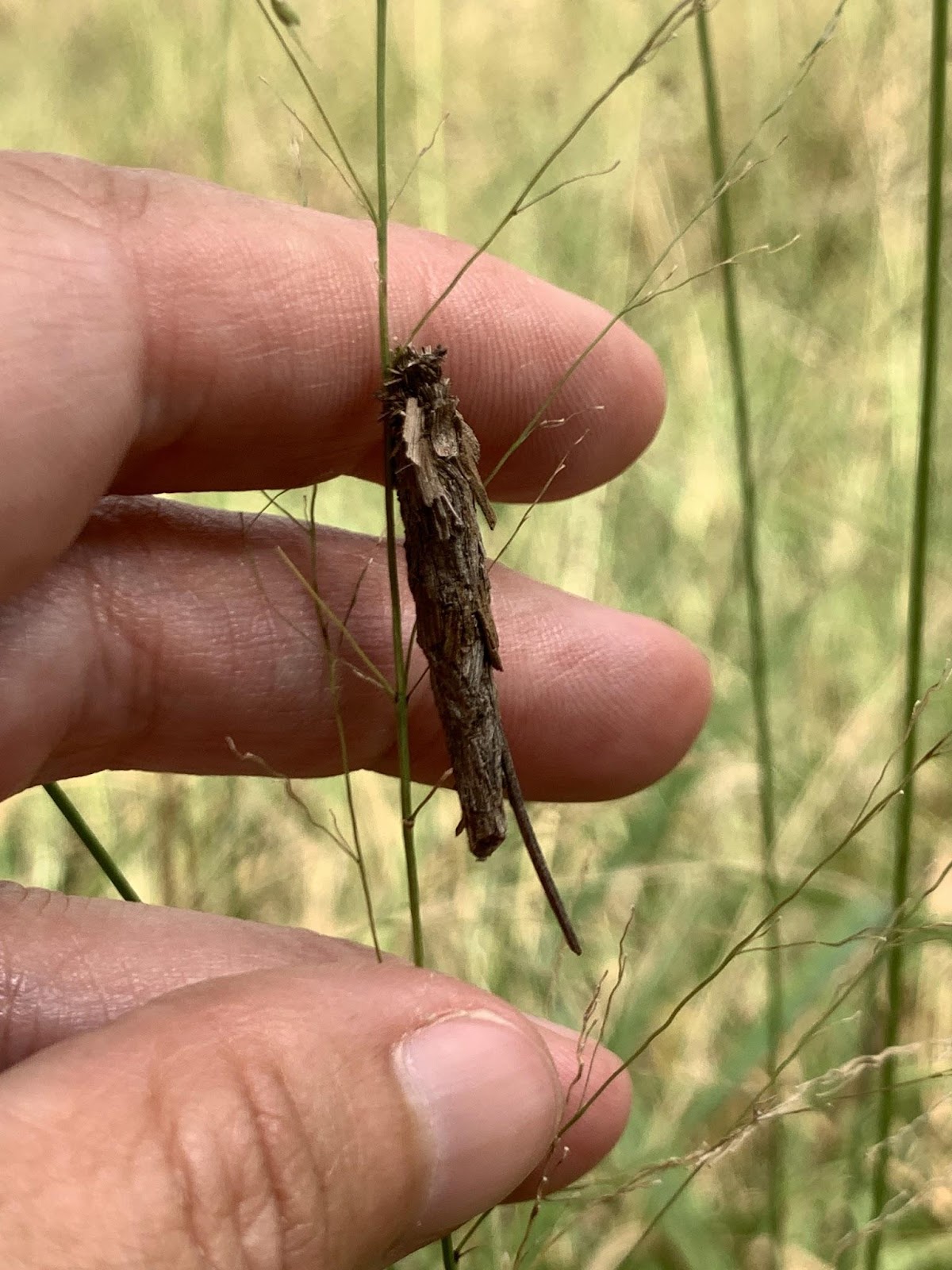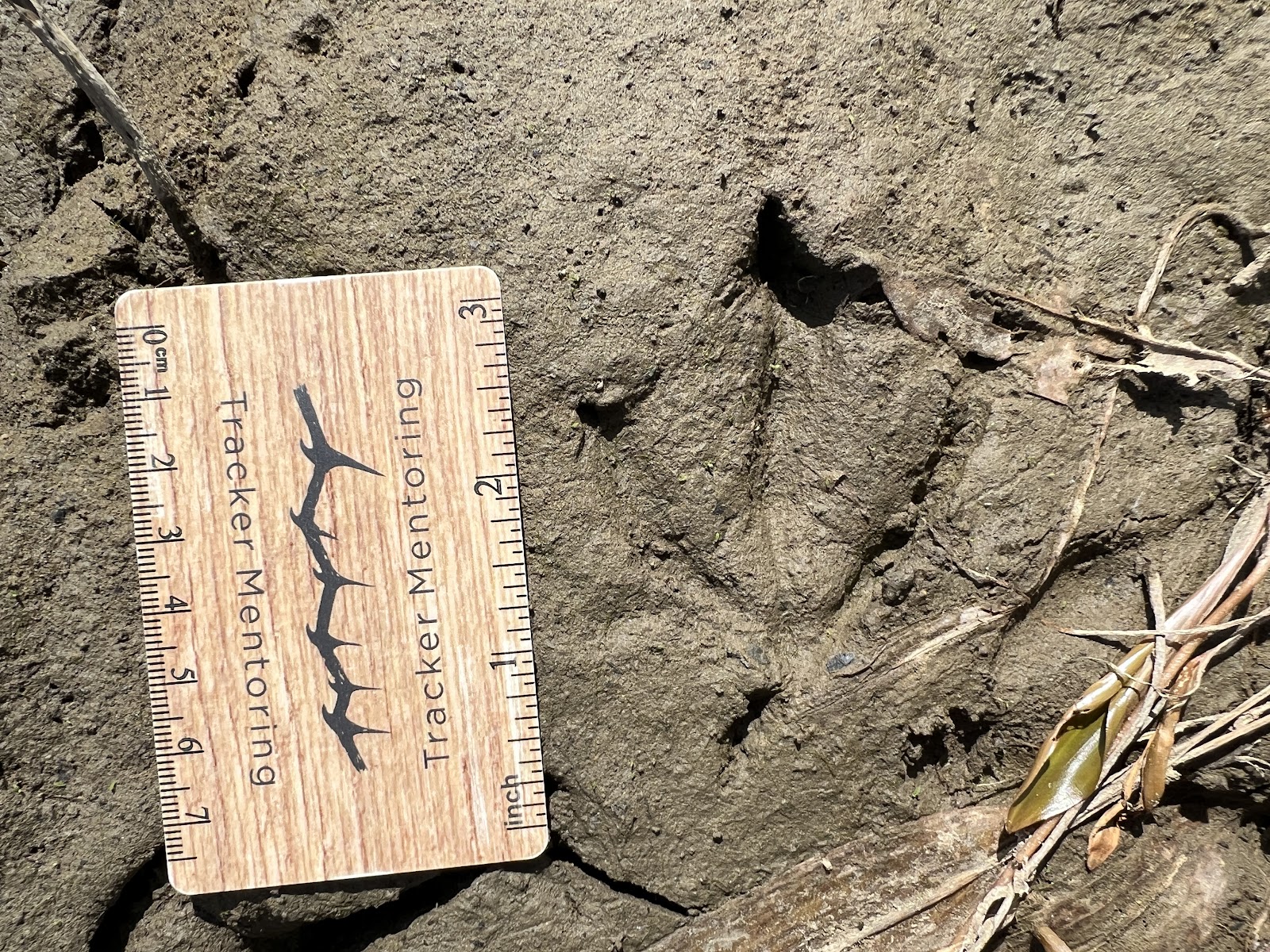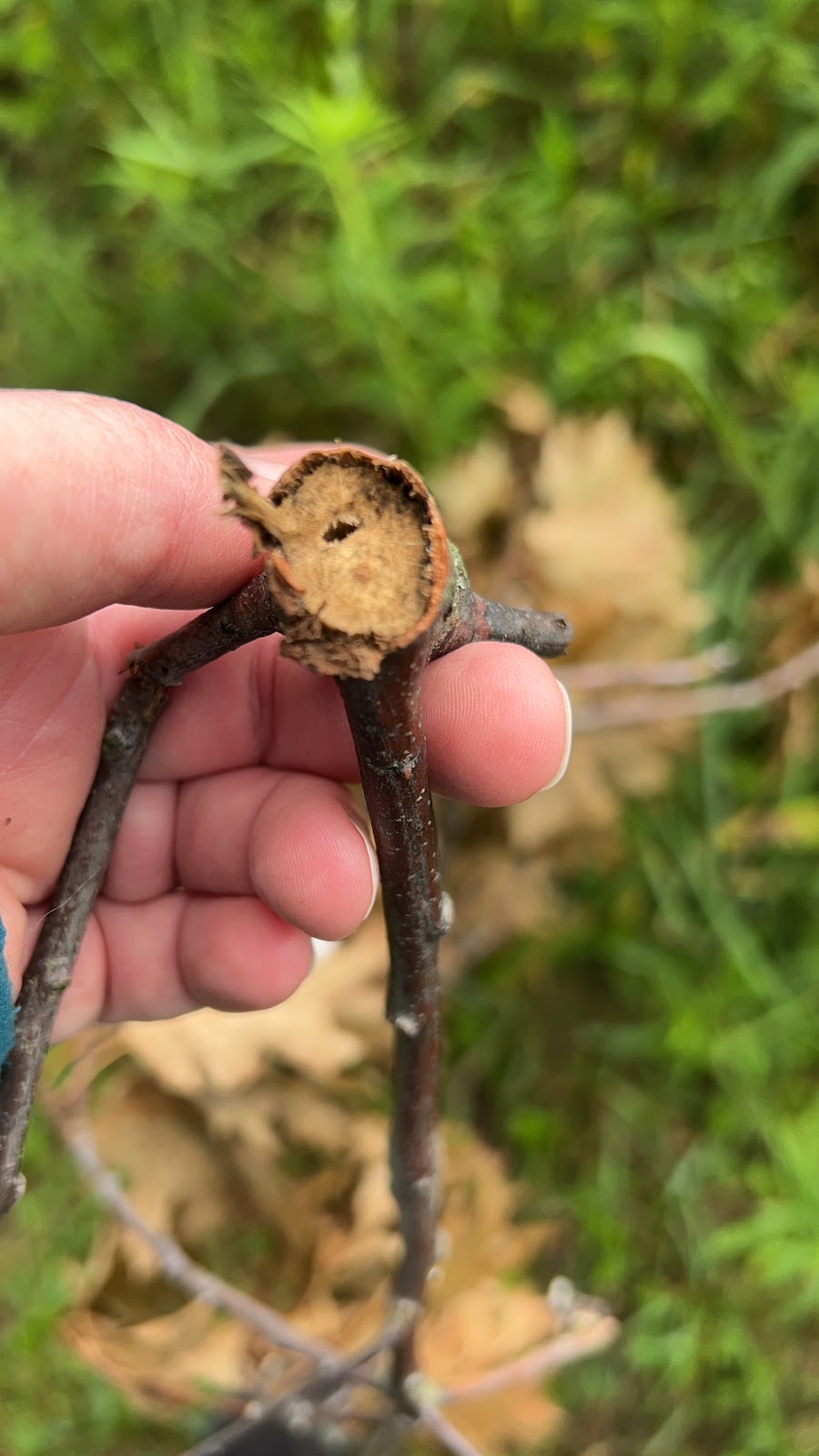February 2024 Quiz
NOTE: With all of the answers below, If you have an alternate opinion about any one, please share! We are all here to learn from each other. Even the most experienced trackers continue to expand their knowledge through their own and others’ experiences, so don’t hesitate to share additional information, observations, questions, or experience.
There are 10 questions in this quiz: 1 is from South Africa, 4 come from Sweden, and 3 are from the USA. More exact locations are given with the individual questions.
Question 1.
Photographed by Kersey Lawrence in the Greater Kruger region of South Africa.
Who? Why? Tell us something about the natural history of this.
Scroll down for the answer.

ANSWER: Bagworm moth larval case from the Greater Kruger Area, South Africa. These animals are cosmopolitan, meaning, we find them across the world, varying with the species that makes them. Some are tiny, made by tiny caterpillars, and others are very large. they can be woven with acacia thorns, grasses, sticks, pine needles, and even stones or grains of sand!
Michael shared “Bagworm larval case. I know these as ‘case moth larva’ in Australia. The larva uses silk to attach bits of sticks or leaves etc. to form a sleeping bag like case that it lives in. Their head and legs poke out when it chooses to move around. I assume the camouflaged bag reduces predation and perhaps protection from drying out.”
Joelle adds, “That looks like a bagworm moth casing for the larvae and female. Although I did not know they resided in South Africa. Really cool. I think the female stays in casing and is flightless while the male has wings. The casing is built by the female for protection.”
Question 2.
Photographed by Sören Decraene in Sweden.
Who? Why? Bonus point for describing the track pattern this animal is using.
Scroll down for the answer.

ANSWER: Domestic Dog in an overstep walk. In fact, this was Sören’s Australian cattle dog, but we only expected folks to get to canine. Canines are tricky, because the features are not always clear, or can be deceiving, especially in photos. Everyone said some type of canine, here, with many guessing a fox because the track didn’t look as “sloppy” as a normal domestic dog’s (there are no Arctic foxes there, only red, but, not being from there I wouldn’t expect you to know that, especially from a photo). Australian cattle dogs tend to be very active and athletic, causing them to have a more similar track to their wild cousins than other domestic dogs. But, none of the features fit for fox, as many of you mentioned – especially lacking the distinct chevron in the metacarpal pad, too small for wolf, and no coyotes in Sweden. Still, it’s hard to guess when you aren’t from there and you have to guess the potential species list from range maps, not knowing the exact location and habitat.
While Will wasn’t specific in his answer (sometimes, you can’t be) he was correct with, “Canine. Symmetrical track. 4 toes, claws showing, lack of a 3rd lobe on the heel pad. Looks like an overstep gait with the smaller rear foot landing ahead of the front.” If this were an evaluation, I would have said, “Can you be more specific?” (Maybe not about the species, but definitely about the track pattern.)
Logan was super specific, with, “Ok, well first off this track looks like a canine– 4 toes, claws registering, a box of negative space between toes and pads. I would expect to see more splaying of the toes with a domestic dog. I’d expect there to be more negative space if this was a Red Fox, and I’m not familiar enough with Arctic Fox to make that call, so I will say my best guess is Wolf. As for gait, from the bottom of the picture I would say the animal was in an overstep walk. (with the hind registering in further forward than the front). In the middle of the trail I’d say there was a transition where maybe it did a hitch step or lope before resuming the walk.” While his call for wolf would have been incorrect (if we were asking for species), he’s spot on with the overstep walk.
Many people called this a trot or a lope, but if you identify the front tracks (the larger ones, you’ll see that each group of 2 (right, left, right…) starts with a larger track, and a smaller one is in front of it. The larger track is from a front foot, and the smaller track is from a hind foot. They are paired on the side of the body, so, going up the photo we see: RF, RH, LF, LH, RF, RH, LF, LH, RF, RH, LF, LH (where R=right, L=left, F=front, and H=hind). There isn’t enough space between them (or enough energy in them) to be a trot, and a lope looks something like: RF, LF/RH, LH or RF, RH/LF, LH (the order of the middle 2 tracks can vary some).
Question 3.
Photographed by Sören Decraene in Sweden.
Who? Why?
Scroll down for the answer.

ANSWER: European hare tracks and scat in Sweden (Sören gave me the “local intel” that there are only European hares in this location).
Miki simply said, “rabbit,” which works in many instances because there is a tremendous overlap in size of the pellets which exit the bums of lagomorph species (rabbits and hares).
Kimber worked through the track and asked a lot of great questions as well. She wrote, “A hare. Front feet smaller than hinds, and with four obvious toes in a J shape. Hinds with indistinct toes due to fur but the edge of the track shows where four basically symmetric toes are. Lovely round lagomorph scat in the middle. Can we tell European and mountain hare apart, maybe with good measurements? Or does their size overlap too much? If you take away the extended heel on the hind foot, the hind feet aren’t massively larger than the fronts (like in North American snowshoe hare) so is it possible for this to be an introduced European rabbit who don’t have feet as strongly snow-adapted?”
Question 4.
Photographed by Sören Decraene in Sweden.
Who? Why? (The second photo is a close-up.)
Scroll down for the answer.

ANSWER: Green woodpecker feeding sign on anthills in Sweden.
Logan picks up on the scat and makes a great comparison to flickers in the United States. “I notice the second photo shows a long tubular scat, whitish. The excavations of the mound/hummock look like the animal is foraging, instead of digging a hole for a shelter or burrow. If I saw this in the US I would say that this is Northern Flicker sign and the bird is hunting for ants. I would go with Black Woodpecker, as they are similar to Pileated Woodpeckers who I see spend a surprising amount of time feeding on the ground.”
Question 5.
Photographed by Sören Decraene in Sweden.
Who? Why?
Scroll down for the answer.

ANSWER: Red fox tracks and scat in Sweden. Sören says there are no other foxes in the region of this photo.
There were no “Red Fox” answers to this question but the tracks were not fresh and not very clear.
Kimber narrowed it down to arctic fox which was super close. “Someone who when they sit back on their haunches to poop, has a long metatarsal bone that registers on both sides of this short, cylindrical scat. Little definition to the tracks themselves. Arctic fox, with furred feet? Feet seem too small for lynx. Interested to see there are introduced raccoon dogs in Sweden, which I have zero reference for, but sounds like they prefer to scat in latrines.”
Question 6.
Photographed by Shane Hawkins in Western New York, USA
Scroll down for the answer.

ANSWER: Fisher tracks
Will narrowed it down with, “Mustelid family. Oblong asymmetrical tracks. Furry feet, and 5 toes in some photos. The first digit is set back and not visible in all photos. It looks like there is negative space between the toes and the metacarpal pad. Fisher of marten?”
And Logan refined it, with, “I notice the tracks are in groups of 4. In several of the tracks I am seeing 5 toes. The size, morphology, and gait lead me to some sort of mustelid. Just vibing on the size of the tracks I lean towards Fisher.”
Question 7.
Photographed by Shane Hawkins in Northwestern Pennsylvania.
Scroll down for the answer.

ANSWER: Duck
Will wrote “Waterfowl, possible duck due to size and 3 forward-facing webbed toes and a visible hallux in the back.”
Michael added some more details. “Right foot print of some type of duck or goose or similar – front three toes are webbed, angle of toes 2 and 4 is about 90 degrees, two 4 is slightly curved inwards, short hind toe pointing back and diagonally inward. Size is good for a duck. Habitat – looks like muddy ground perhaps associated with a wetland environment.”
QUESTION 8.
Photographed by Shane Hawkins in Western New York

“Two different beetles cause this twig loss in the Northeast. Both are members of the huge Longhorn Beetle family, Cerambycidae, with more than 35,000 species found world-wide. Most species, including the two in the Northeast, have distinctly long antennae (horns?) and eat plant tissue like twigs, stems, and roots. The taxonomy of these beetles is predictably complex and disputed.”
“Twig Pruner Beetles (genus and species names of this beetle are uncertain and different sites give very different names), are native long-horned beetles, ¾” long, brownish, slender and elongate. They have two posterior spines on each wing cover and their antennae are longer than their bodies. The Twig Pruner prefers oaks but also attacks other hardwoods, like dogwood, elm, honey locust, hickory, but around here it really favors our Red Oaks. When the oaks begin leafing out, these beetles lay their eggs at the tips of the host tree branches up to 1 inch in diameter, one egg per tip. When the eggs hatch, the growing larvae, called roundheaded borers, which are the usual legless white with black heads, bore into the stems and tunnel down them. They winter over inside the twigs, continuing to feed again the next spring. In midsummer they cut around the inside of each branch, but leave the thin cambium layer and bark intact. Eventually the twigs’ weight or the wind snaps them off. Look at the end of a leaf cluster with a Twig Borer and you should see a hole in the inner pith plugged with frass (the beetle poop) to protect the overwintering larvae from predators. The larvae remain inside their now fallen stems, eventually pupating in the twig over the winter, to emerge as adult beetles the following spring when they will fly up into the host tree to lay the next generation of eggs.”
“A different long-horned beetle, Oncideres cingulata, girdles rather than cuts off the leafy twigs and it has a similar life cycle as the Borer. The Twig Girdler is about ¾” long but it is grey-brown with a lighter stripe across its wing covers (its elytra) and its antennae are about the same length as its body, not longer. Adult beetles emerge in late summer when the females girdle a twig and lay a single egg in the cut portion so their eggs can feed on the dying wood; these larvae don’t eat live wood, unlike the Twig Borer. The girdled terminal quickly falls to the ground that first summer. The Girdler Beetle can be identified by looking at the cut end with its smooth V-shaped outer cut and ragged torn inner wood, quite distinct from the Twig Borer’s cut appearance with the visible tunnel inside. The Twig Girdler larvae bore further into the fallen twig, spending the winter and the next spring inside until they pupate and emerge as adults to start the cycle again.”
And this photo comparison came from Master Gardeners of Greene Co, Springfield, MO:

Photographed by Shane Hawkins in Southern Vermont

ANSWER: Rabbit chew sign
Mark made some comparisons. “”Rabbit cambium feeding. Too big and chunky for vole, not regular enough for beaver.
Kimber narrows it down to lagomorph. “Someone cambium feeding on a stick, leaving a somewhat rough surface and maybe just on one side of the stick like they couldn’t manipulate it to eat both sides. Looks like the front surface of the incisors have grooves in them. Snowshoe hare, or other local lagomorph.”
QUESTION 10.
Photographed by Shane Hawkins in Western New York

Logan identified them correctly as red fox, but I don’t see the direct register described, “Gorgeous tracks. Canine, with neat toes and thin claws. Maybe a lot of negative space in the track. I’d say Red Fox. Not seeing the chevron in the carpal pad, but tbh I don’t see it most times. How many animals is a great question. I’d say two animals, one in a direct register gait on the left, and another leaving a trail on the right.”
Please go to OriginalWisdom.com and subscribe to our email list if you’d like to continue to receive these quizzes, along with our news, updates, and calendar of programs for North America and Africa.
You can also view old quizzes on the Original Wisdom website under the Resources tab, in the Tracking Gallery.
We are building a tracking database as a resource for learners. CONTACT US if you would like to submit photos from your area of the world for these quizzes – it does not have to be Africa or North America.
Subscribe to Original Wisdom
Recent Blog Posts
Blog Tag Cloud
Blog Archive
Archives
Brandon Willis Legacy Scholarship
One hundred percent of donations made in Brandon’s name are set aside to help provide for a high school or college student to travel to South Africa to participate in an Original Wisdom program. The student must have a strong passion for photography and/or wildlife tracking and be a part of a program or class that is learning about and working towards conservation.

